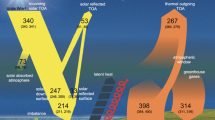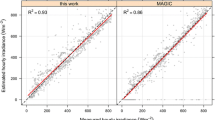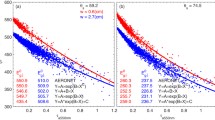Abstract
The Ångström–Prescott equation defines generically the relationship between solar energy available at ground level and sunshine duration. From the very beginning in the history of the solar energy converters, the equation was extensively used to estimate the amount of collectable solar energy. In the present paper, we propose a different way of looking to the Ångström–Prescott equation, namely, to use it for the estimation of cloud and clear sky atmospheric transmittances. The key tools are the mathematical expressions which give the clear sky and cloud transmittances in terms of the Ångström–Prescott empirical coefficients. The theory is verified by comparing the mean all-sky atmospheric transmittance (innovatively inferred from the cloud and clear sky atmospheric transmittances) with the measured clearness index. Reasonably good concordance between the two quantities has been found. It was shown that the best performance is obtained with the linear Ångström–Prescott equation. Higher-order polynomial equations tend to overfit the measurements. Examples are also shown about how to use the linear Ångström–Prescott equation to obtain information about the time series stationarity and the seasonal sensitivity of the cloud and clear-sky transmittances. The present point of view gives the perspective to estimate past cloud and clear-sky climatology in places where the Ångström–Prescott equation has been fitted to the sunshine data.






Similar content being viewed by others
Data availability
Not applicable. Data are publicly available at WRDC. The source was suitably cited.
Code availability
Not applicable.
References
Akinoglu B (2008) Recent advances in the relations between bright sunshine hours and solar irradiation. In: Badescu V (ed) Modeling solar radiation at the earth surface. Springer, London, pp 115–143
Akinoglu BG, Ecevit A (1990) A further comparison and discussion of sunshine-based models to estimate global solar radiation. Energy 15:865–872
Ångström A (1924) Solar and terrestrial radiation. Report to the international commission for solar research on actinometric investigations of sola and atmospheric radiation. Q J Roy Meteor Soc 50:121–126
Ångström A (1956) On the computation of global radiation from records of sunshine. Arkif Geof 19(2):471–479
Brabec M, Badescu V, Dumitrescu A, Paulescu M (2016) A new point of view on the relationship between global solar irradiation and sunshine quantifiers. Sol Energy 126:252–263
Despotovic M, Nedic V, Despotovic D, Cvetanovic S (2015) Review and statistical analysis of different global solar radiation sunshine models. Renew Sust Energ Rev 52:1869–1880
García RD, Cuevas E, García OE, Cachorro VE, Palle P, Bustos JJ, Romero-Campos PM, de Frutos AM (2014) Reconstruction of global solar radiation time series from 1933 to 2013 at the Izaña Atmospheric Observatory. Atmos Meas Tech 7:3139–3150
Harrison GR, Chalmers N, Hogan RJ, RJ, (2008) Retrospective cloud determinations from surface solar radiation measurements. Atmos Res 90(1):54–62
Liu BYH, Jordan RC (1960) The interrelationship and characteristic distribution of direct, diffuse and total solar radiation. Sol Energy 4:1–19
Liu X, Mei X, Li Y, Porter JR, Wang Q, Yanqing Zhang Y (2010) Choice of the Ångström-Prescott coefficients: are time-dependent ones better than fixed ones in modeling global solar irradiance. Energ Convers Manage 51(12):2565–2574
Liu Y, Tan Q, Pan T (2019) Determining the parameters of the Ångström-Prescott model for estimating solar radiation in different regions of China: calibration and modeling. Earth Space Sci 6:1976–1986
Martinez-Lozano JA, Tena F, Onrubia JE, De La Rubia J (1984) The historical evolution of the Ångström formula and its modifications: review and bibliography. Agr Forest Meteorol 33:109–120
Mousavi R, Sabziparvar AA, Marofi S, Pak NAE, Heydari M (2015) Calibration of the Angström-Prescott solar radiation model for accurate estimation of reference evapotranspiration in the absence of observed solar radiation. Theor Appl Climatol 119:43–54
Paulescu M, Schlett Z (2003) A simplified but accurate spectral solar irradiance model. Theor Appl Climatol 75:203–212
Paulescu M, Stefu N, Calinoiu D, Paulescu E, Pop N, Boata R, Mares O (2016) Ângström-Prescott equation: physical basis, empirical models and sensitivity analysis. Renew Sust Energ Rev 62:495–506
Prescott JA (1940) Evaporation from a water surface in relation to solar radiation. T Roy Soc South Aust 64:114–212
Samanta S, Patra PK, Banerjee S, Narsimhaiah L, Chandran SMA, Kumar VP, Bandyopadhyay S (2019) Generation of common coefficients to estimate global solar radiation over different locations of India. Theor Appl Climatol 136:943–953
Stefu N, Paulescu M, Blaga R, Calinoiu D, Pop N, Boata R, Paulescu E (2016) A theoretical framework for Ångström equation. Its virtues and liabilities in solar energy estimation. Energ Convers Manage 112:236–345
Stanhill G, Achiman O, Rosa R, Cohen S (2014) The cause of solar dimming and brightening at the Earth’s surface during the last half century: evidence from measurements of sunshine duration. J Geophys Res Atmos 119:10902–10911
Sun X, Jamie M, Bright JM, Gueymard CA, Bai X, Acord B, Wang P (2021) Worldwide performance assessment of 95 direct and diffuse clear-sky irradiance models using principal component analysis. Renew Sust Energ Rev 135:110087
Wild M, Long CN, Ohmura A (2006) Evaluation of clear-sky solar fluxes in GCMs participating in AMIP and IPCC-AR4 from a surface perspective. J Geophys Res 111:D01104
WRDC (2021) World Radiation Data Center, Main Geophysical Observatory, St. Petersburg, Russia. http://wrdc.mgo.rssi.ru/ [accessed March 2021].
**ao M, Yu Z, Cui Y (2020) Evaluation and estimation of daily global solar radiation from the estimated direct and diffuse solar radiation. Theor Appl Climatol 140:983–992
Zhang Z, Xu X, Qiao L, Gong D, Kim S-J, Wang Y, Mao R (2018) Numerical simulations of the effects of regional topography on haze pollution in Bei**g. Sci Rep 8:5504
Acknowledgements
The authors thank the reviewer for useful comments and suggestions.
Funding
Two authors (MP and VB) acknowledge support from the Romanian Ministry of Education and Research, CCCDI—UEFISCDI, project number PN-III-P2-2.1-PED-2019–3942.
Author information
Authors and Affiliations
Contributions
All authors contributed to the study conception and design. Data collection and pre-processing were performed by Sanda Budea and Alexandru Dumitrescu. Data processing and analysis were performed by Marius Paulescu and Viorel Badescu. The first draft of the manuscript was written by Viorel Badescu and Marius Paulescu. All authors read and approved the final manuscript.
Corresponding author
Ethics declarations
Ethics approval
Not applicable. The study does not include humans and/or animals.
Consent to participate
Not applicable. The study does not include humans and/or animals.
Consent for publication
Not applicable. The study does not include humans and/or animals.
Conflict of interest
The authors declare no competing interests.
Additional information
Publisher's note
Springer Nature remains neutral with regard to jurisdictional claims in published maps and institutional affiliations.
Supplementary Information
Below is the link to the electronic supplementary material.
Rights and permissions
About this article
Cite this article
Paulescu, M., Badescu, V., Budea, S. et al. What Ångström—Prescott equation tells us about the cloud and clear-sky climatologies?. Theor Appl Climatol 147, 239–250 (2022). https://doi.org/10.1007/s00704-021-03805-8
Received:
Accepted:
Published:
Issue Date:
DOI: https://doi.org/10.1007/s00704-021-03805-8




